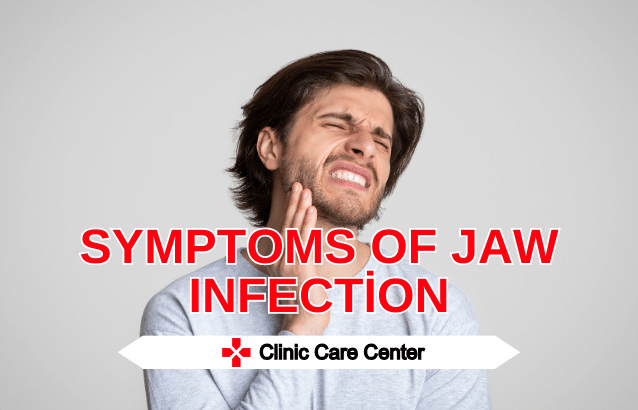A jaw infection, also known as a periapical abscess, is a serious complication that can occur after a root canal procedure. It is caused by bacteria that invade the jawbone surrounding the treated tooth. Symptoms of a jaw infection after a root canal can include:
- Persistent pain and increased tooth sensitivity: Pain is a common symptom after a root canal, but it should gradually subside within a few days. If the pain is severe, persistent, or worsens, it could be a sign of infection. Pain may also be aggravated by biting or chewing.
- Formation of an abscess: An abscess is a pus-filled pocket that forms in the jawbone. It can cause swelling, tenderness, and redness in the gums around the affected tooth. You may also notice a small, pimple-like bump on the gums.
- Tooth discoloration: A tooth that has been infected may become discolored, turning gray or brown.
- Chronic bad breath: Bad breath that doesn’t go away with brushing and flossing could be a sign of a jaw infection.
- Constant bad taste in the mouth: An unpleasant taste in the mouth, such as a metallic or sour taste, could be another symptom of infection.
- Unexplained fatigue: Feeling tired or sluggish could be a sign that your body is fighting an infection.
- Unexplained or sudden fever: A fever is a sign that your body is fighting an infection. If you have a fever along with any of the other symptoms mentioned above, it is important to see your dentist right away.
If you experience any of these symptoms after a root canal, it is important to see your dentist immediately. Prompt treatment is necessary to prevent the infection from spreading to other areas of your body. Treatment for a jaw infection after a root canal may include antibiotics, drainage of the abscess, or further root canal therapy.
Introduction to Root Canal Procedure
The root canal procedure is a common dental intervention designed to alleviate pain and save a damaged tooth. During this process, the pulp of the tooth is removed, and the space is cleaned and sealed. While most patients experience a smooth recovery, there are instances where complications, such as jaw infections, may arise.
Normal Healing Process
Typically, the healing process after a root canal involves a gradual reduction in pain and discomfort. Most patients can expect to return to their normal activities within a few days, armed with improved oral health.
Signs of a Complication: Jaw Infection
Despite the routine nature of root canals, jaw infections can occur. Recognizing the signs of a potential infection is crucial for timely intervention. This article explores the symptoms that may indicate a jaw infection after a root canal.
Immediate Post-Root Canal Symptoms
In the immediate aftermath of a root canal, some discomfort and mild swelling are normal. However, persistent or worsening symptoms could be indicative of a problem. We delve into what is expected and what may be cause for concern.
Delayed Onset Symptoms
Jaw infections may not always manifest immediately. Understanding symptoms that could arise days or even weeks after the procedure is essential for identifying potential complications in a timely manner.
Pain and Discomfort
One of the primary indicators of a jaw infection is persistent or escalating pain. We explore the nuances of pain after a root canal, differentiating between normal discomfort and signals of an underlying issue.
Swelling and Inflammation
While some swelling is expected post-procedure, excessive or prolonged swelling could indicate an infection. We discuss the visual cues and sensations associated with abnormal inflammation.
Fever and Systemic Symptoms
A systemic response, such as fever, can accompany a jaw infection. We outline how to monitor for these broader symptoms and their significance in the context of post-root canal care.
Discharge or Pus Formation
Unusual discharge or the formation of pus near the treated tooth can be alarming. We explain how these visible signs may point to an infection and the importance of addressing them promptly.
Complications and Risk Factors
Certain factors may increase the risk of complications after a root canal. We explore these risk factors and their role in predisposing individuals to jaw infections.
When to Seek Emergency Care
Knowing when to seek emergency dental care is crucial. We provide a guide on recognizing urgent situations and the steps to take for immediate assistance.
Diagnosis of Jaw Infection After Root Canal
Dentists employ various diagnostic tools to identify jaw infections. We shed light on the diagnostic process and the importance of early and accurate identification.
Treatment Options
Timely intervention is key in managing jaw infections. This section outlines the potential treatment options, ranging from antibiotics to more advanced dental procedures.
Preventing Infections After Root Canal
Prevention is the best medicine. We discuss strategies for minimizing the risk of infections after a root canal, emphasizing the role of good oral hygiene and post-procedure care.
Conclusion and Follow-up Care
In conclusion, this article emphasizes the significance of recognizing symptoms, seeking prompt care, and following through with recommended post-root canal care. By being proactive, patients can navigate the healing process more smoothly and enjoy the long-term benefits of a successful root canal procedure.
